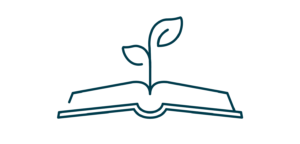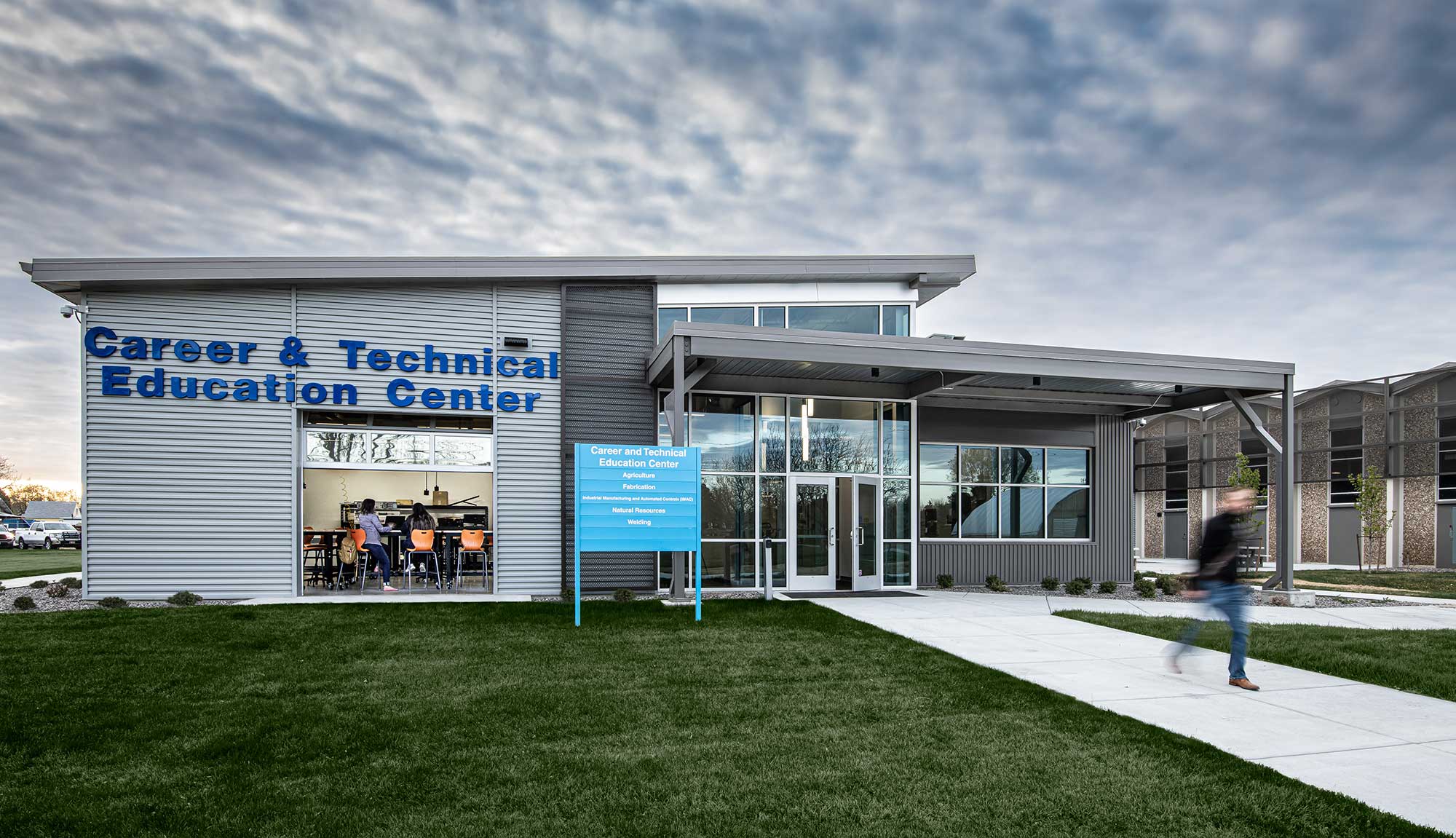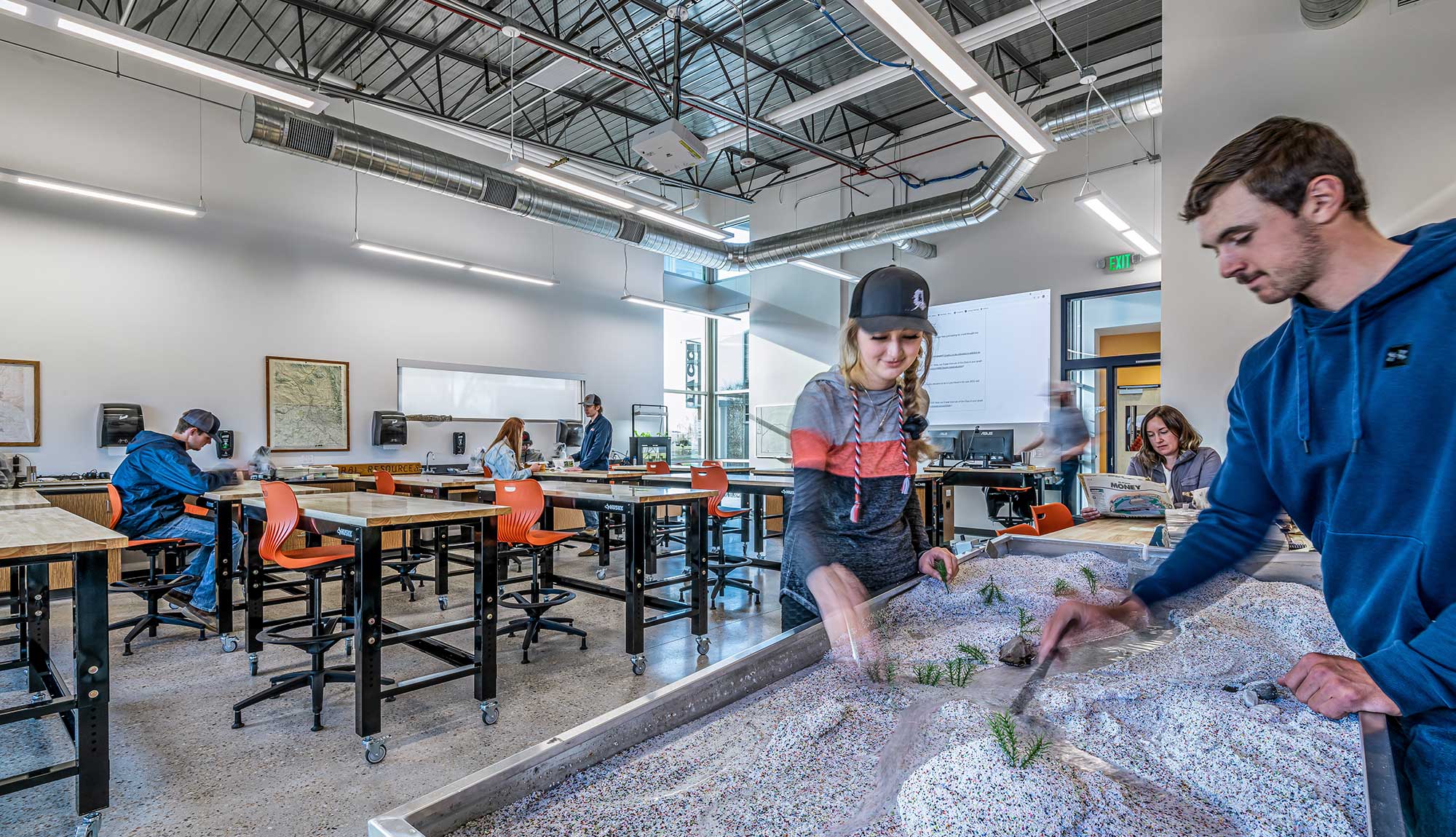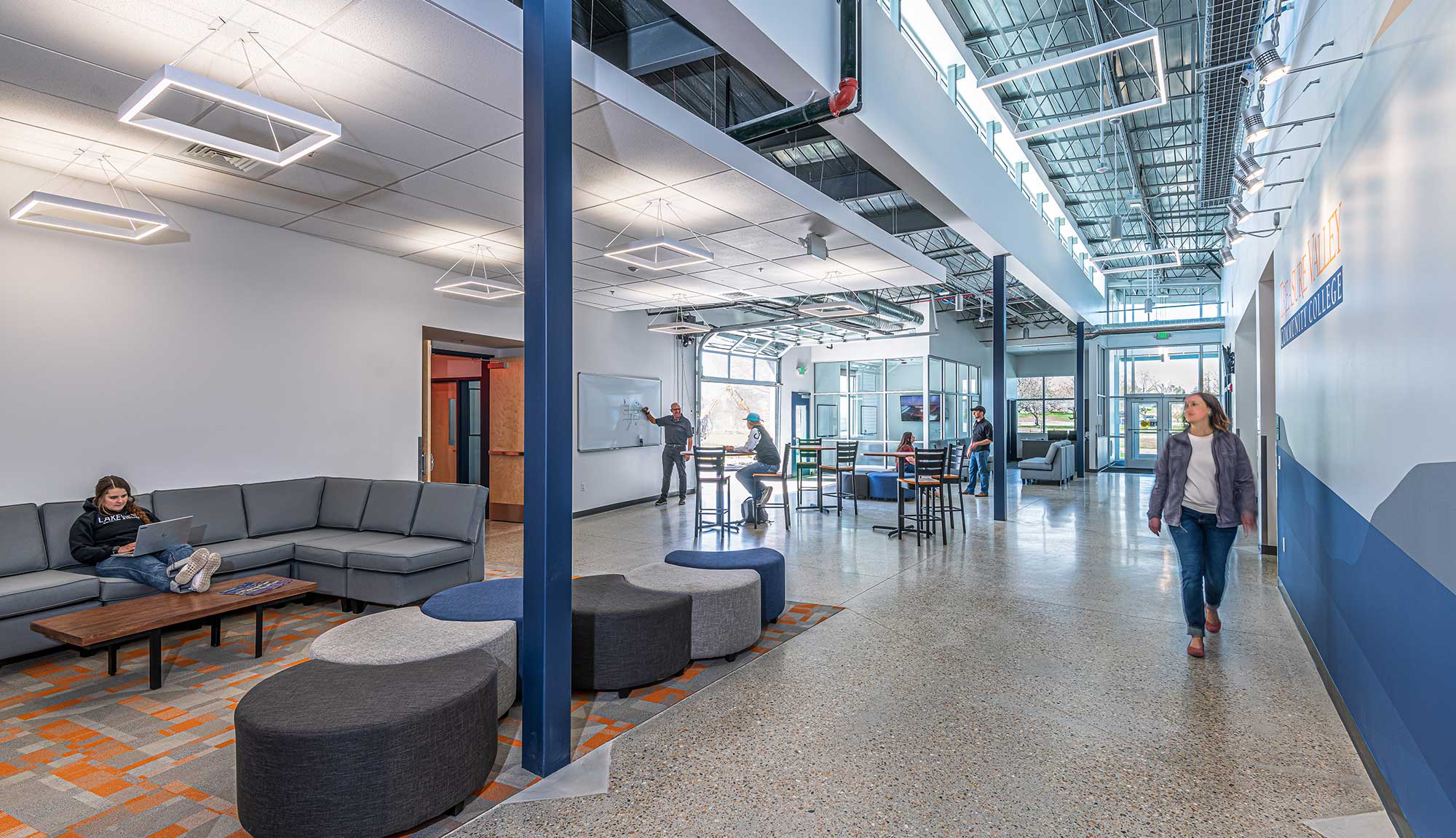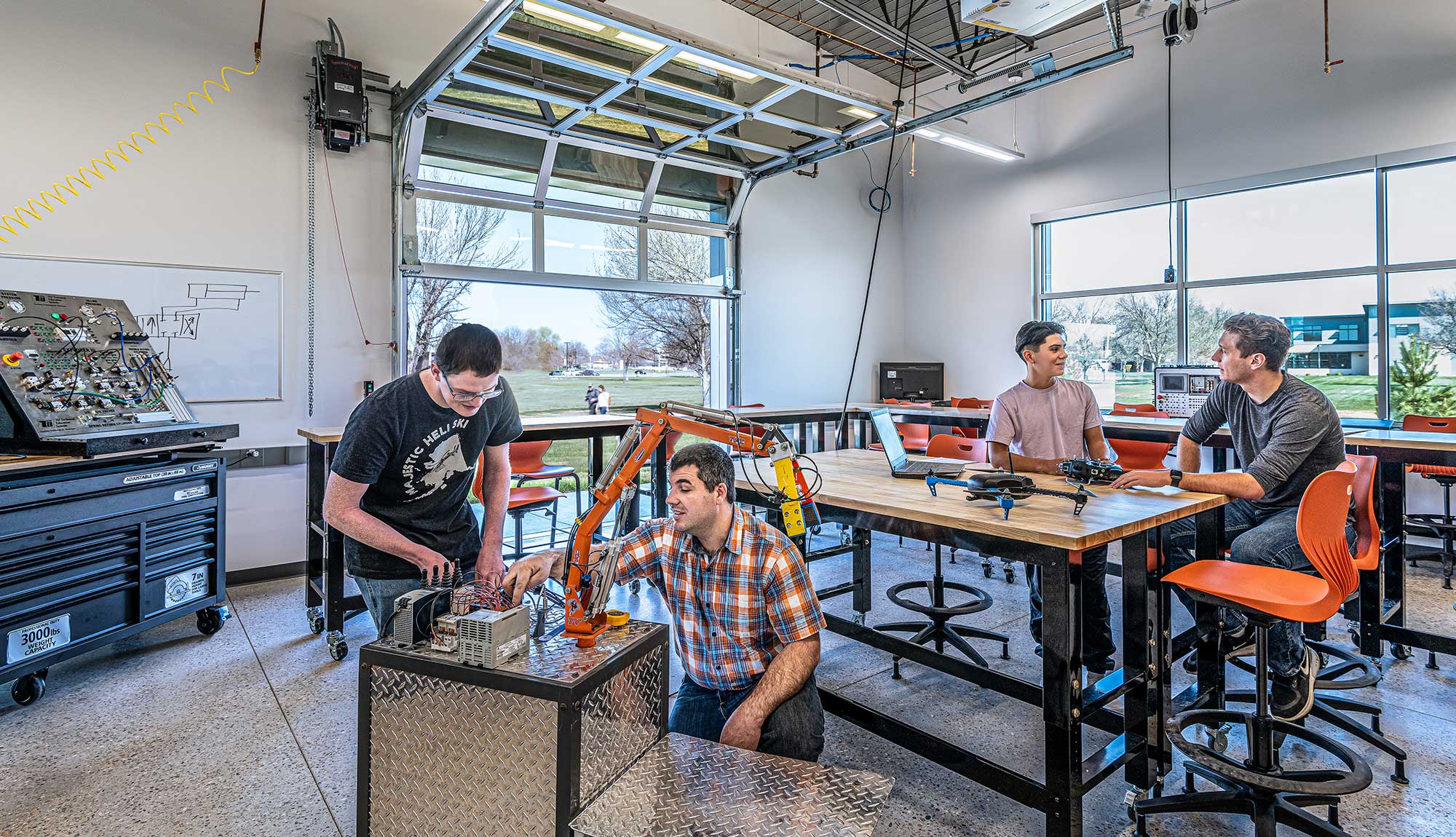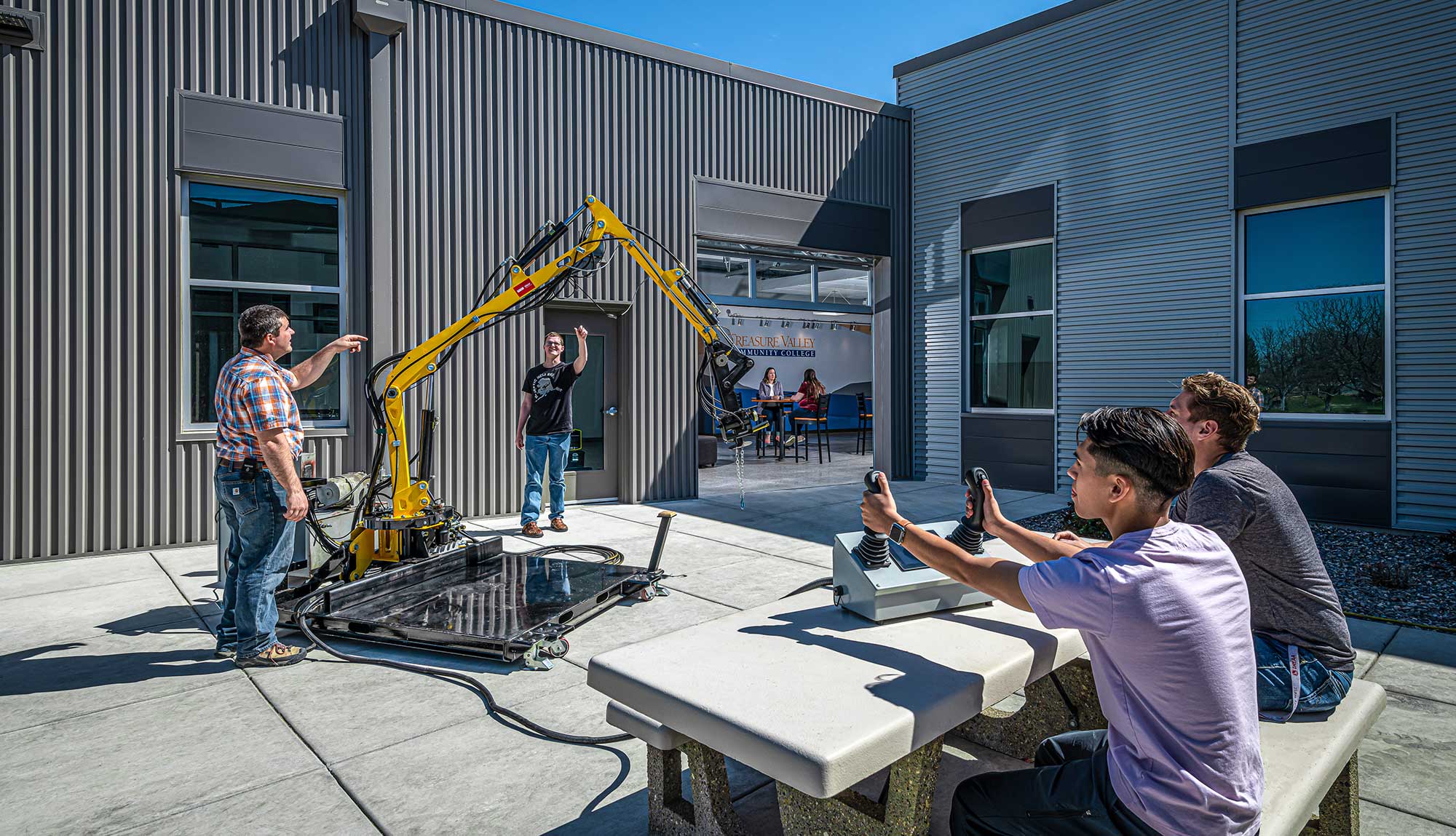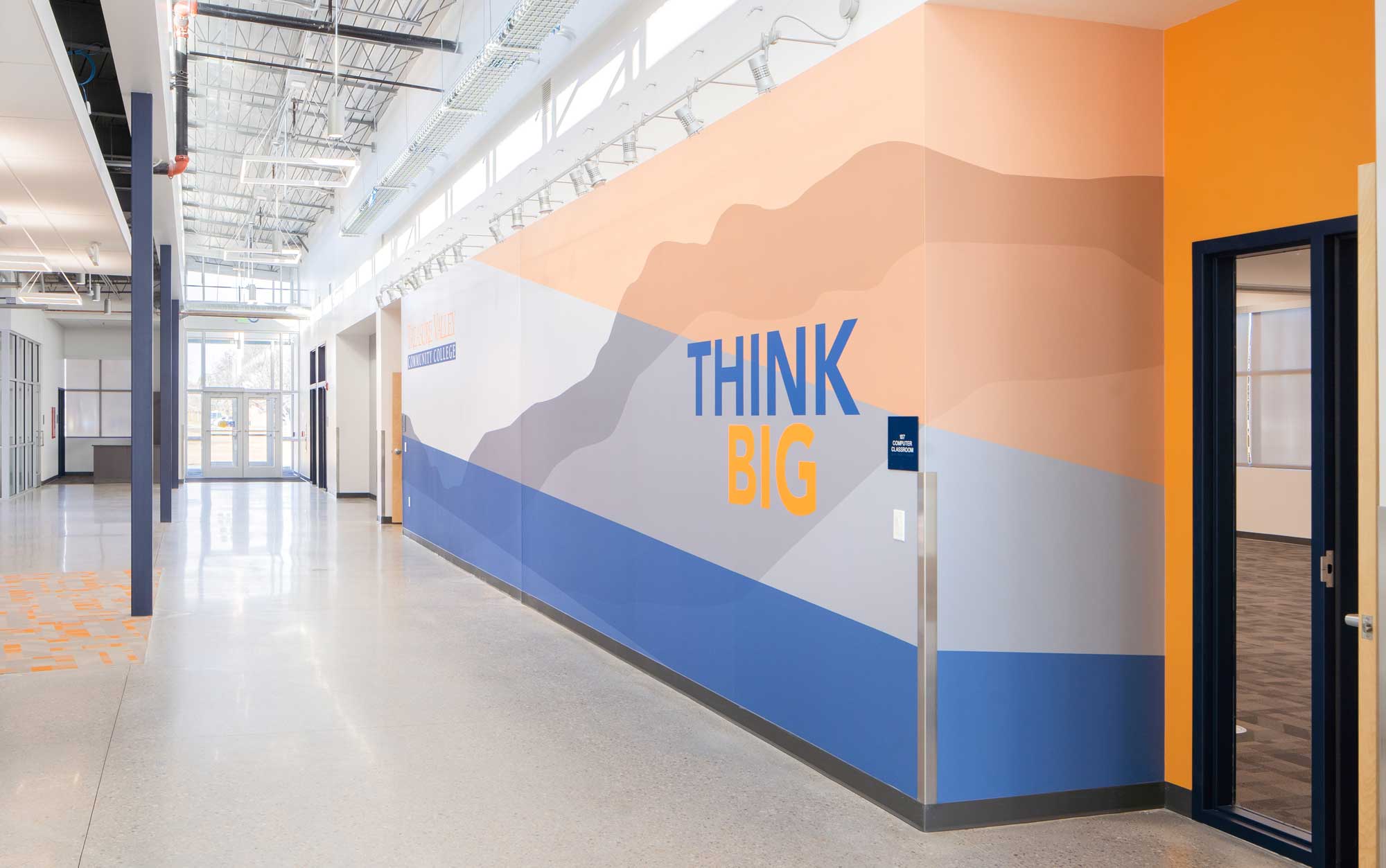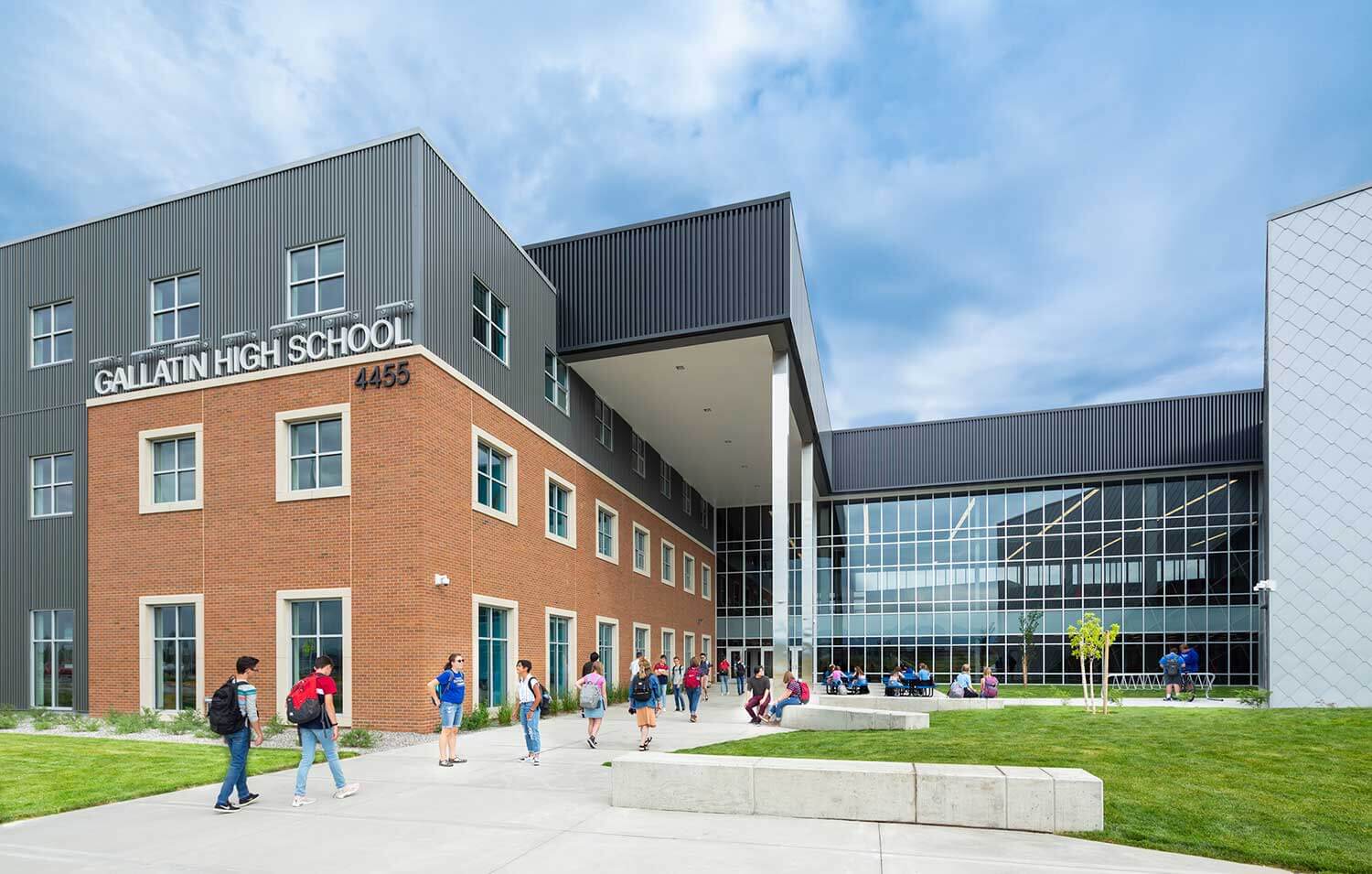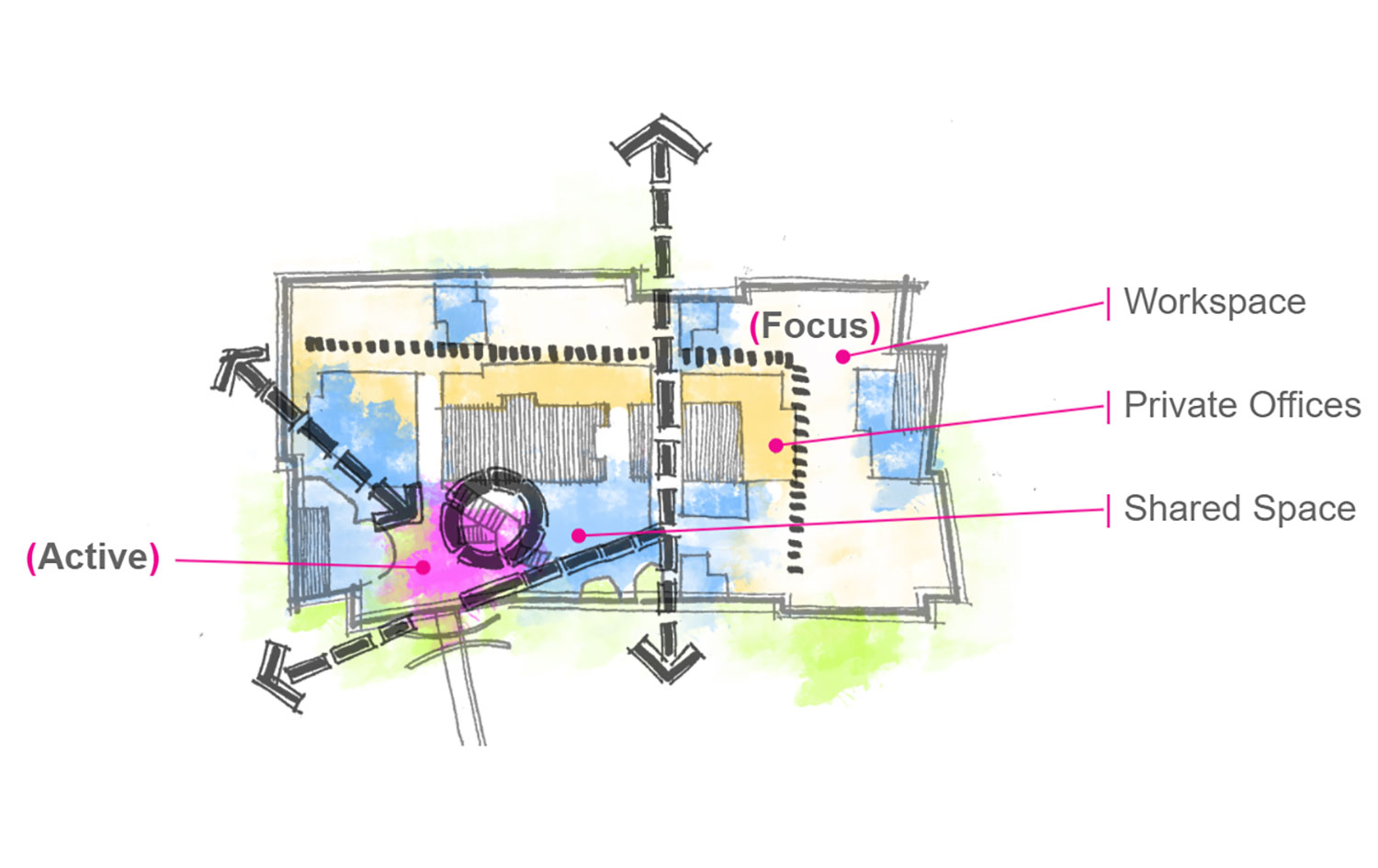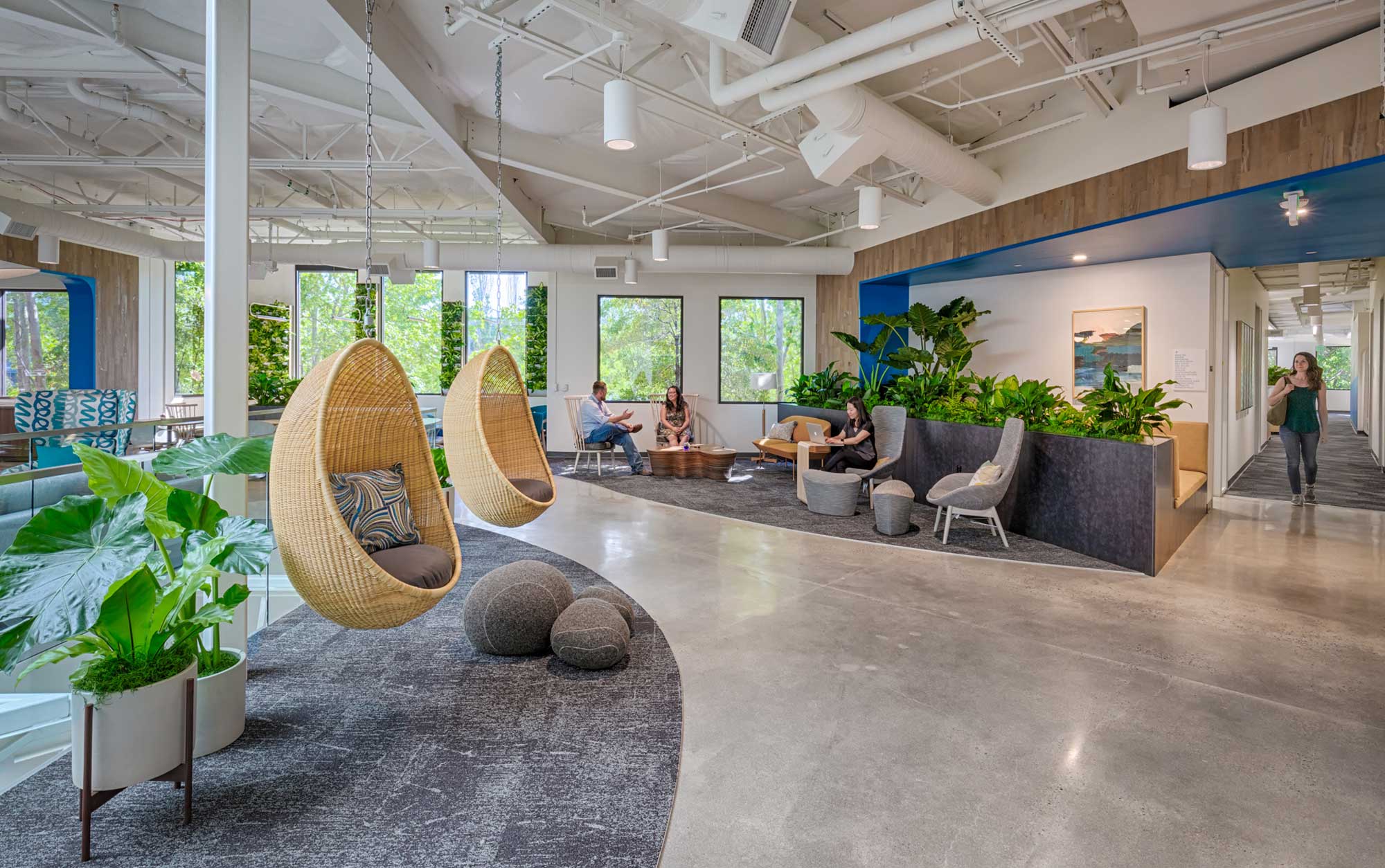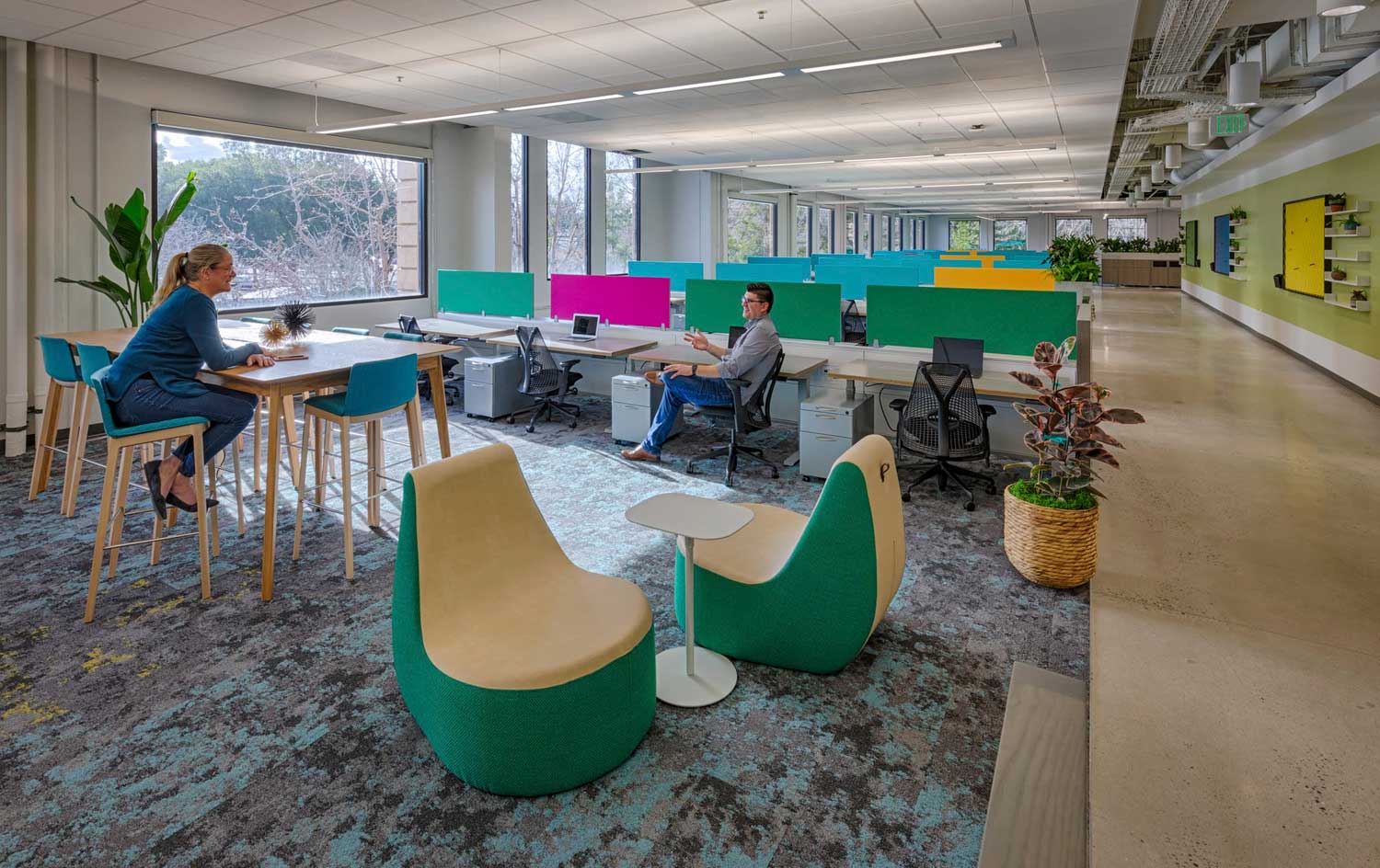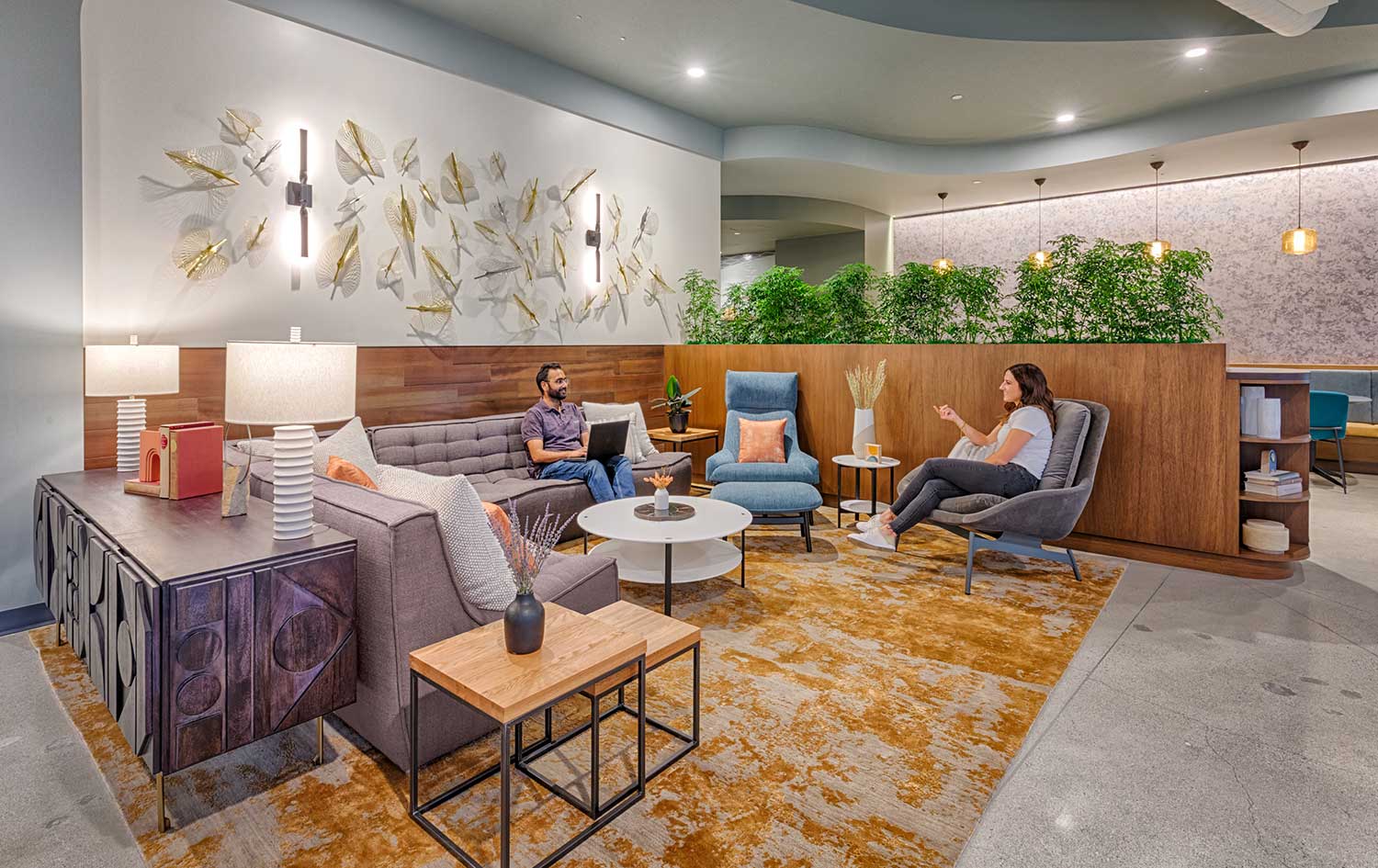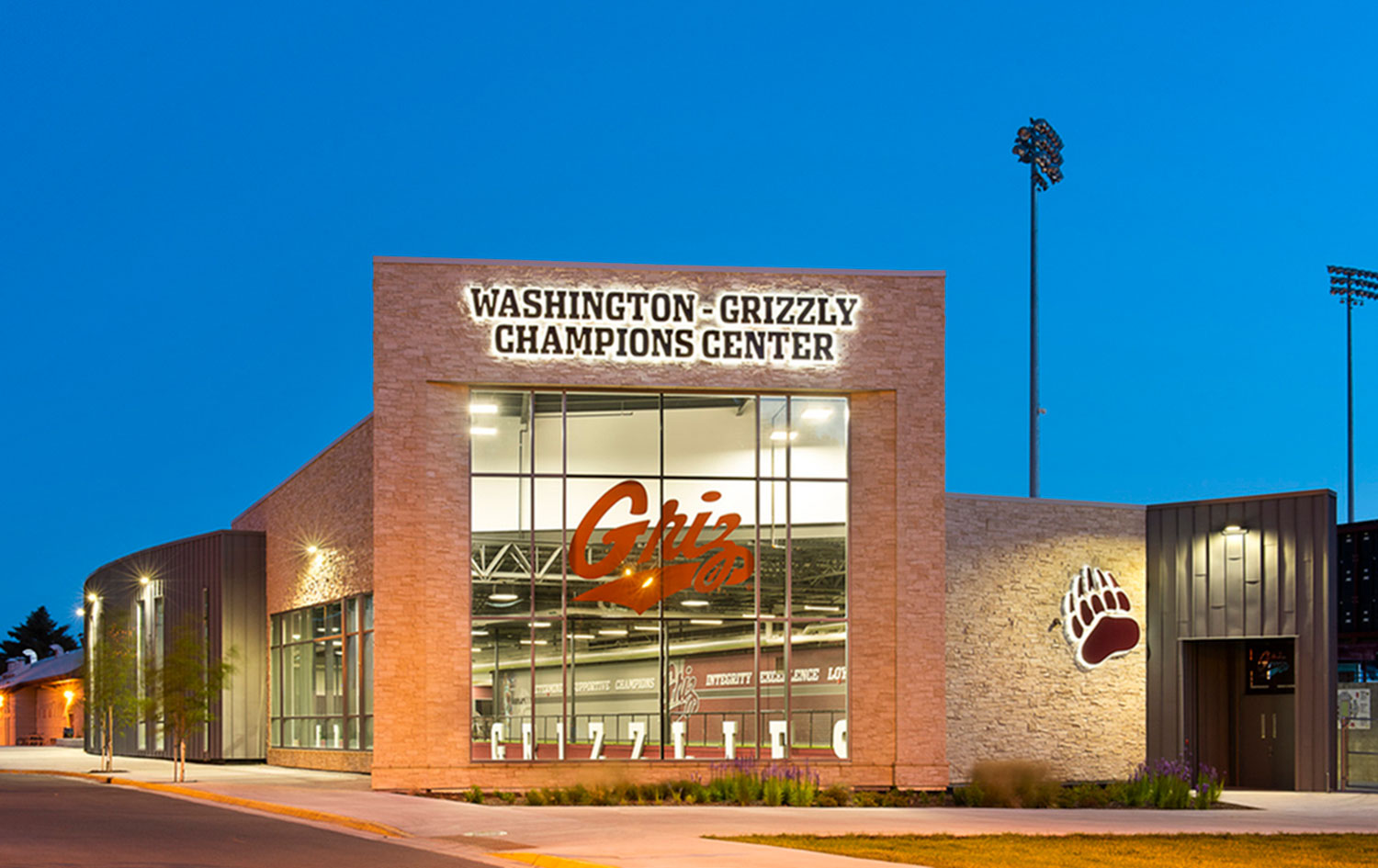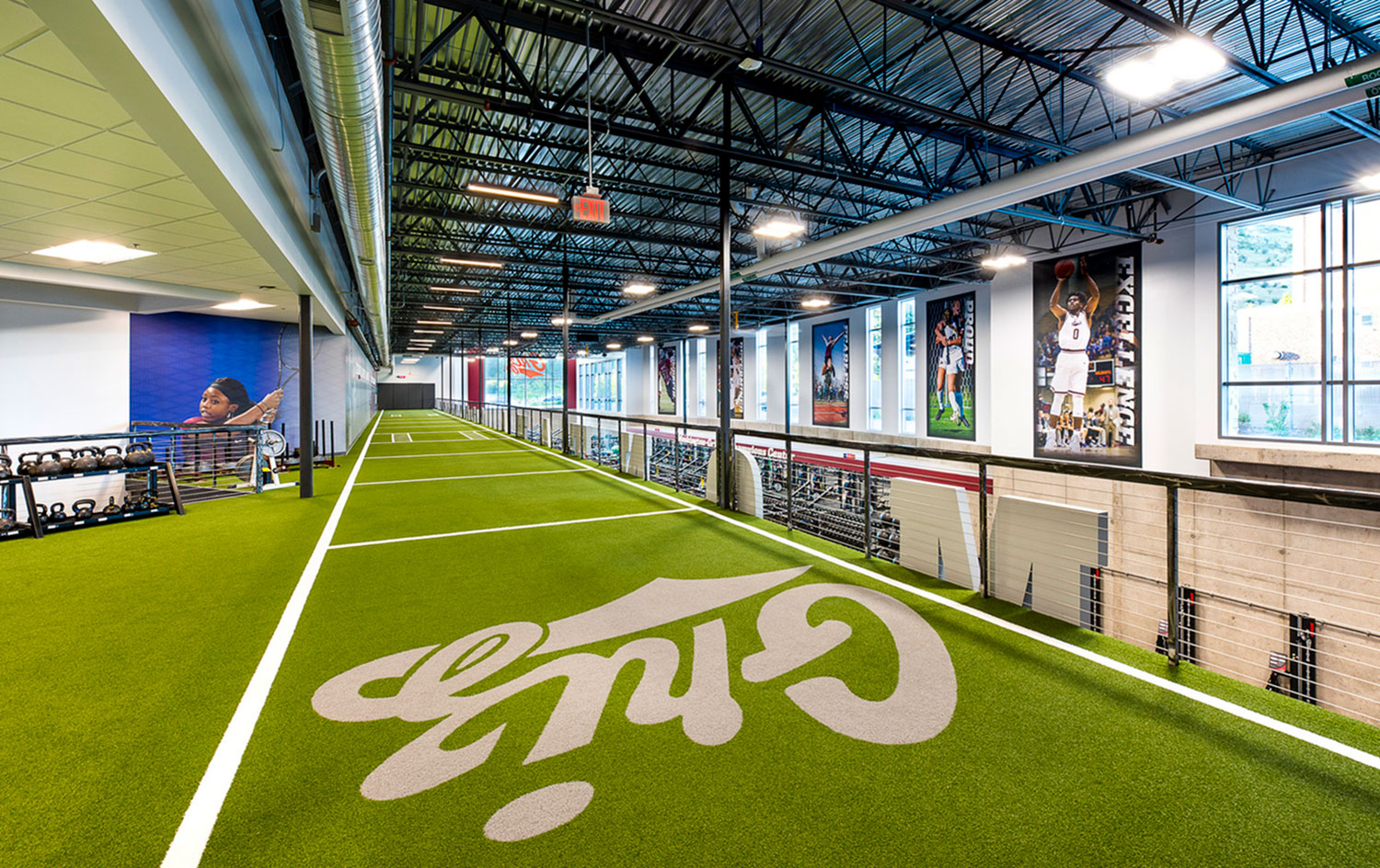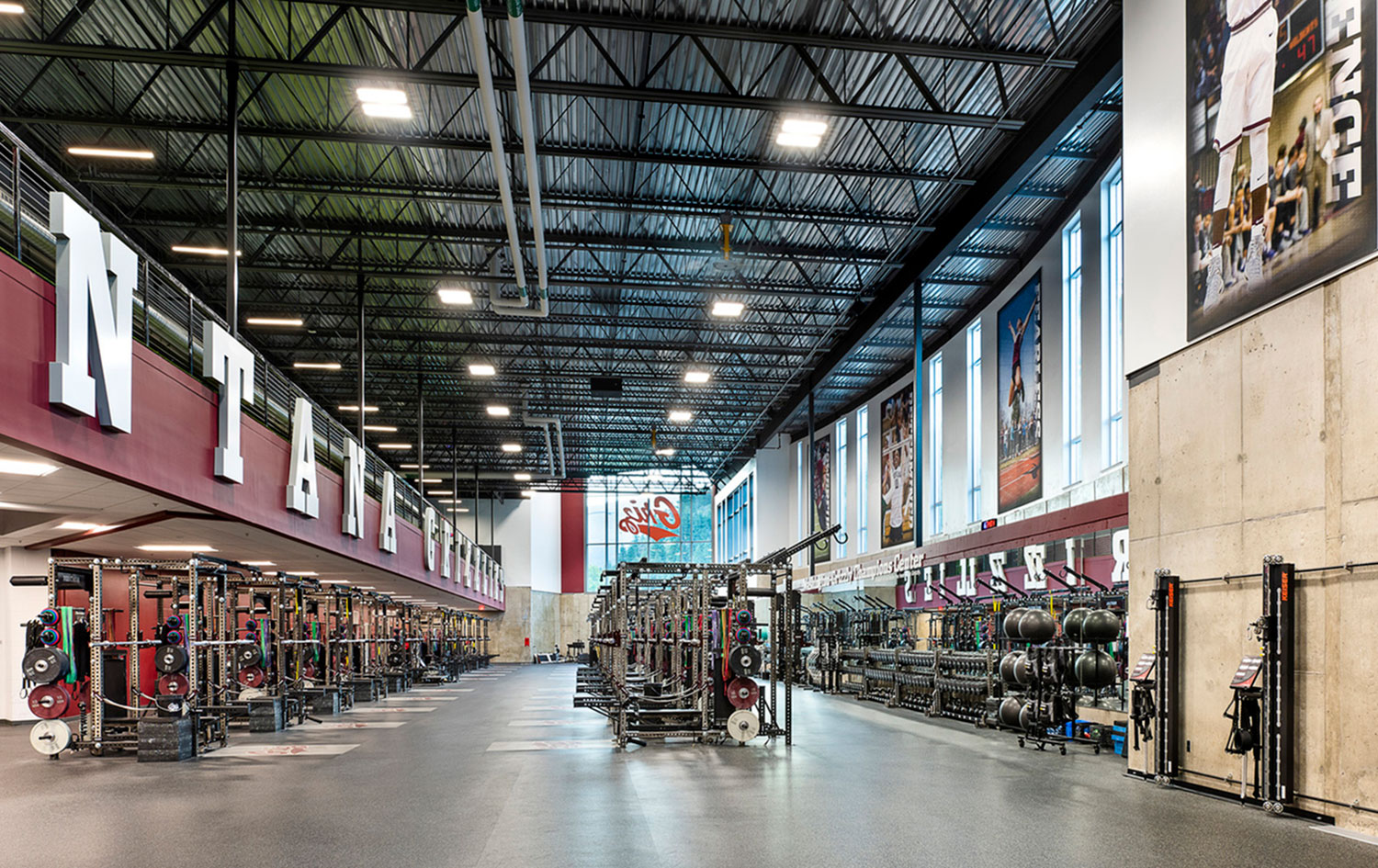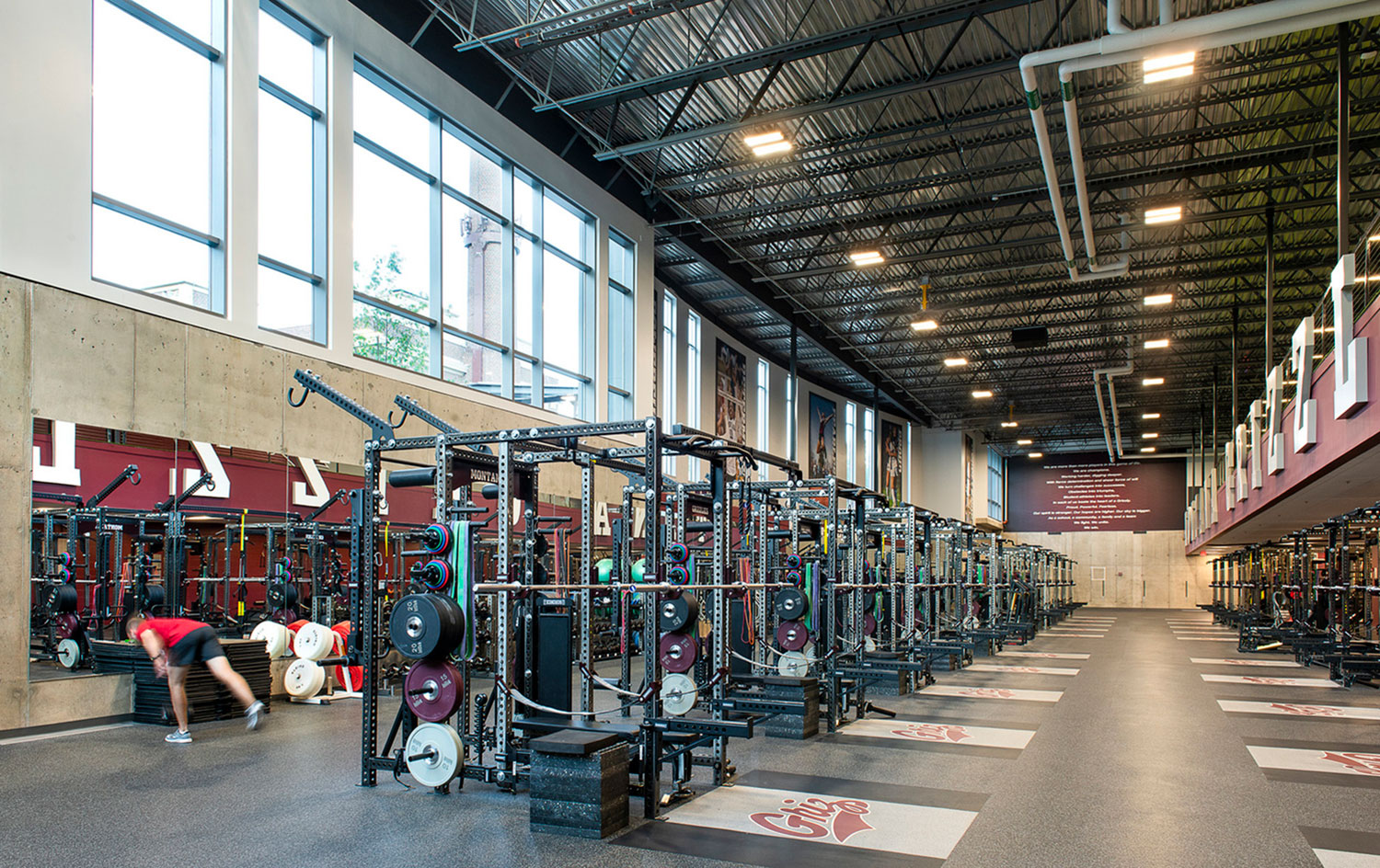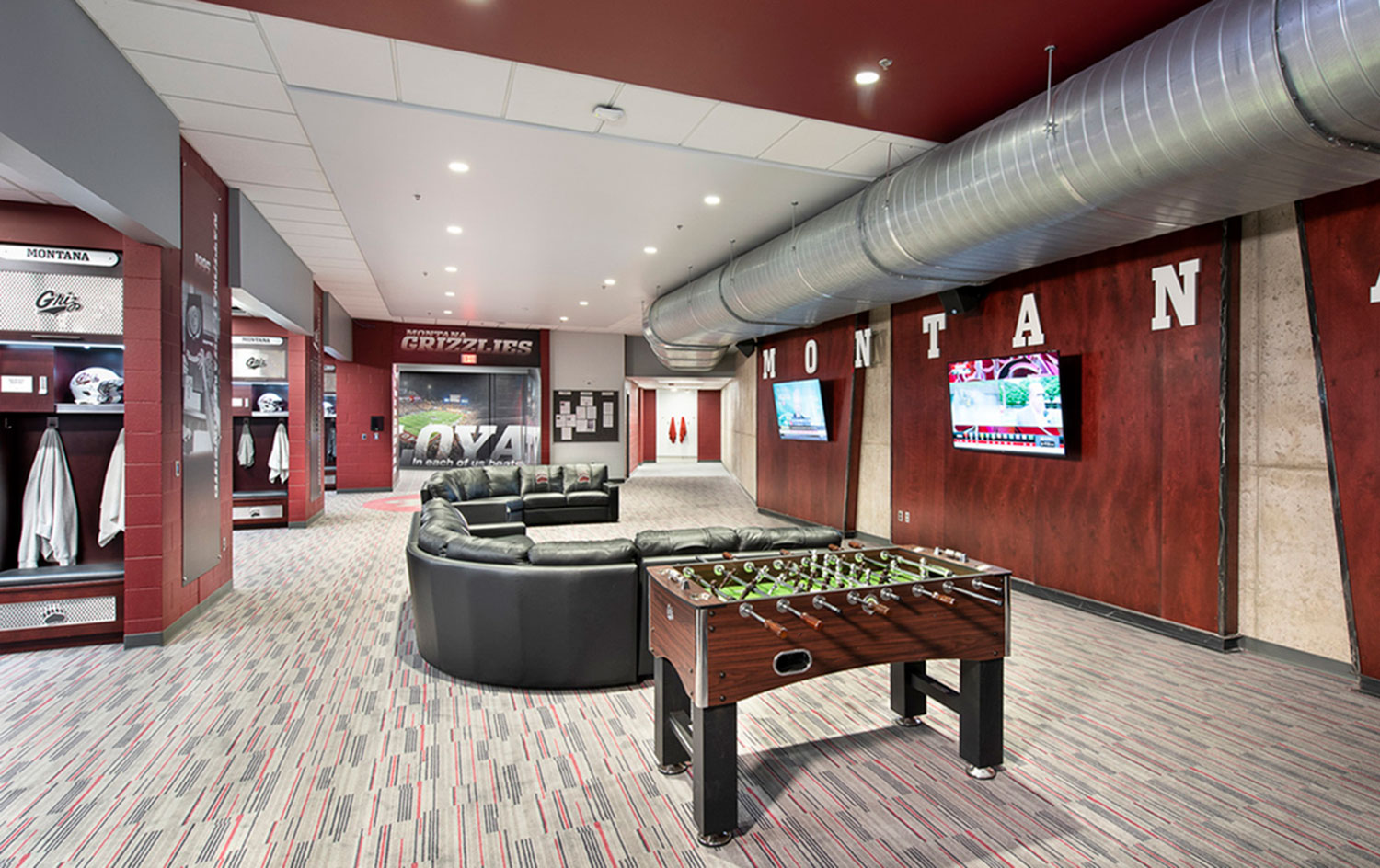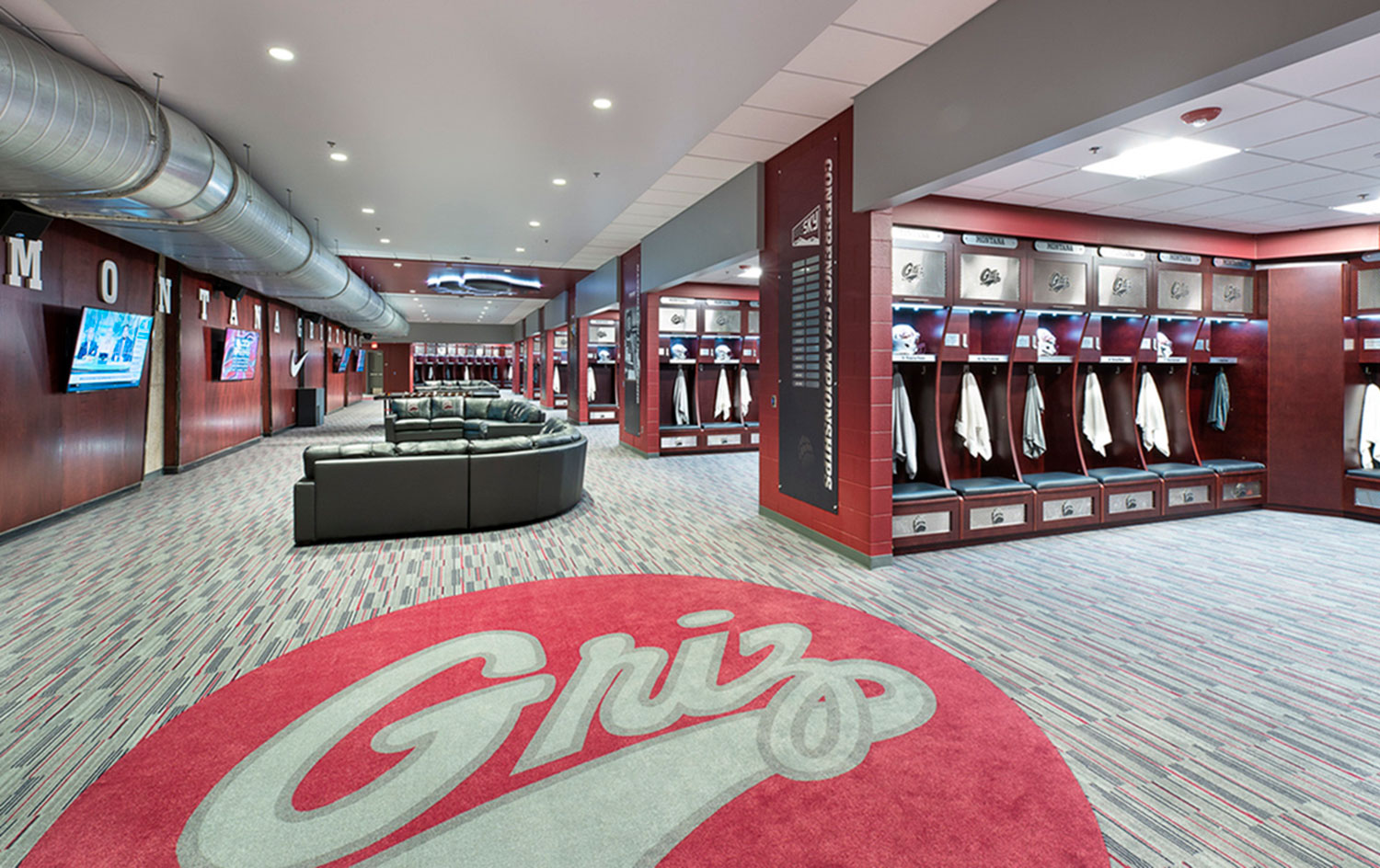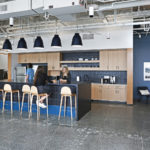The Ecology of Education: Designing Optimal, Evolving Learning Environments
The role of the designer is to immerse themselves in the world of the user groups they design for while keeping an eye on the bigger picture, pulling in knowledge and inspiration from a variety of sources. How we live, work, and learn is constantly changing, and so too must the practice of how we design for the built environment. With this desire to understand user groups as well as address fluctuating needs and circumstances, our approach to design must be responsive and facilitate the transfer of knowledge and new ideas.
THE APPROACH
Within the world of education, the primary functions of teaching and learning take center stage, but influencing these functions is the context of the overall educational ecosystem and what our team calls the “Ecology of Education.” Through this lens, we study how students interact with each other; how they interact with teachers, support staff, and administrators; and how all these groups interact with and within their environments. As architects and engineers, we view our role as your partners in designing learning environments, continually developing a deeper understanding of the interactions within schools so our designs can better accommodate the needs of everyone within them.
Ecology is defined as the branch of biology that deals with the relations of organisms to one another and to their physical surroundings. Similarly, Cushing Terrell’s multidisciplinary team uses the “Ecology of Education” as our approach to understanding user groups and designing the best learning environments for them.
At Cushing Terrell, our design practice follows the motto: “Imagine… Create… Improve.” Our approach to the Ecology of Education is no different. We strive to 1) imagine the possibilities for learning; 2) create intentional, sustainable, holistic environments; and 3) improve our knowledge of education through research, evaluation, and experience.
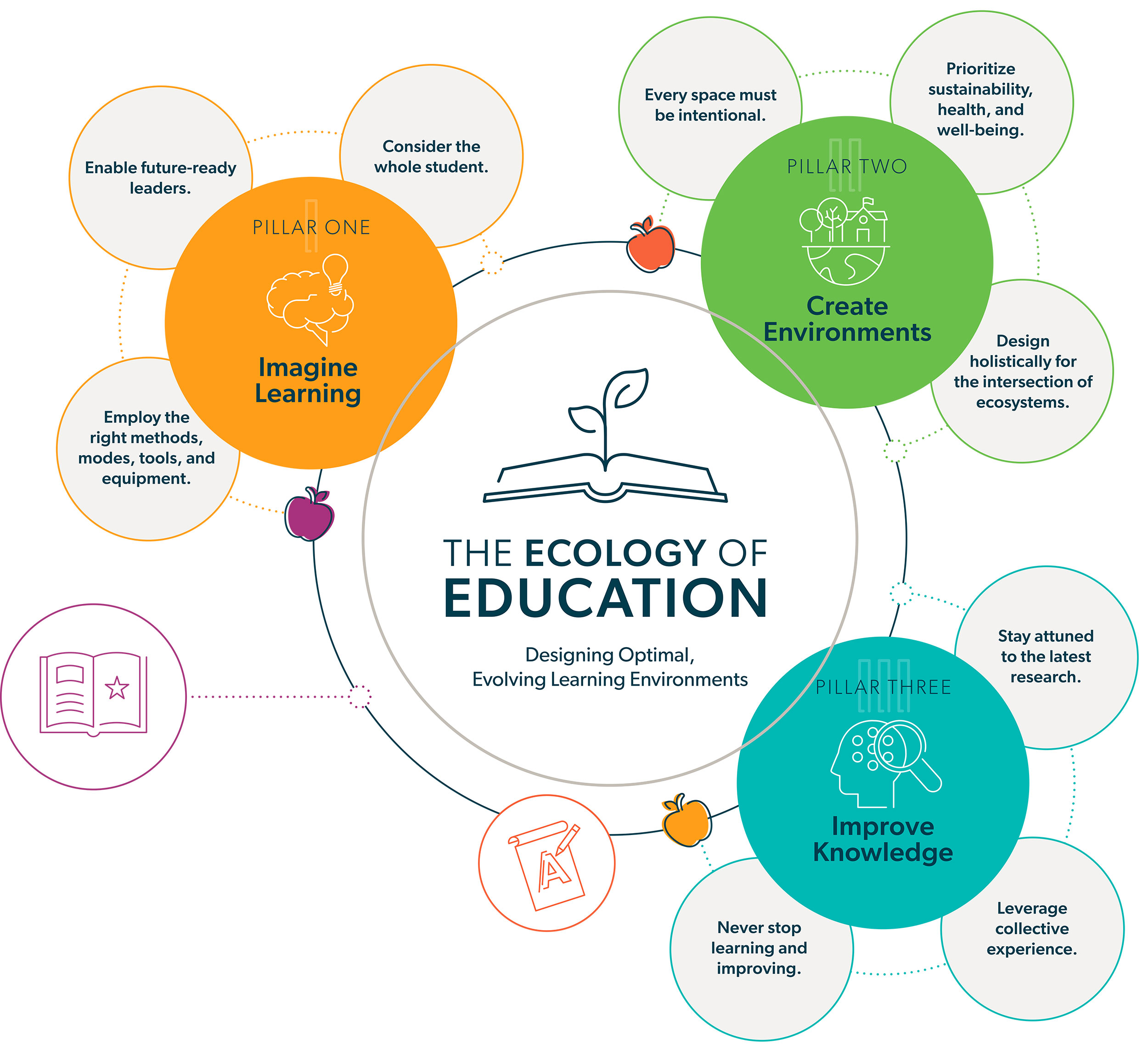
THE FRAMEWORK
The three pillars of our Ecology of Education design approach are: Imagine Learning, Create Environments, and Improve Knowledge. The activities aligned with these pillars do not occur in a vacuum — each project and project phase inform the others in a process that begins and ends in research.
PILLAR #1 — IMAGINE LEARNING: The methods, deliverables, and project examples that depict how we take our understanding of education, as well as knowledge from other sectors, and apply it to the development and design of learning environments.
Objectives and Tactics:
Enable future-ready leaders. Regardless of the curriculum, the age of the student, or the location of the school, the goal of education is to equip learners with the knowledge and skills needed to be successful in life. Whether focusing on a career path; attending a university, college, or trade school; enlisting in military service; or embarking upon any life adventure, we must ensure students can thrive as leaders, actively contributing to their own personal growth, cultivating growth in others, and improving the world around them. In tandem with educational leaders and their unique vision for education, we aim to imagine all the possible ways students might prepare for their futures so we can design optimal environments within which to learn.
Consider the whole student. It’s widely accepted that academic success is neither a guarantee nor the sole contributor to success in life. To prepare students for their futures, schools must teach to the whole student, including supporting the development of social skills and healthy relationships, understanding and supporting their emotional needs, and teaching students how to care for their own mental and physical well-being. To be effective, this must occur within an environment and culture that maintain an unerring sense of psychological safety, reinforced not only by policies and procedures, but also systems, equipment, and spaces that support physical security, social-emotional growth, and intellectual stimulation.
Employ the right methods, modes, tools, and equipment. While we tend to recognize and draw inspiration from similarities in interests, talents, and skills, each student approaches learning from their own unique perspective. Students find their passions and develop their strengths through various methods and modes of learning, using tools and equipment that bridge their personalities with the task at hand. Within this spectrum of human difference, great school design starts with an understanding of the broader educational vision, identifies various functions that teach to the whole student, and imagines strategies that allow every element of the learning environment to accommodate and celebrate diverse needs.
What IMAGINE LEARNING looks like.
Project Spotlight: TVCC Career and Technical Education Center
The Career and Technical Education Center at Treasure Valley Community College in Ontario, Oregon, is an immersive, hands-on learning environment focused on giving students the skills to excel in the region’s high-demand industries: agriculture, natural resources, automated systems, welding, and fabrication programs.
The design goals were to create transparency and cohesion between learning spaces and facilitate community and business connections. The building features a “working” lobby with entrances at both ends to welcome students, staff, community members, and industry leaders with comfortable seating, high-top tables, and whiteboards for presentations and career events. The spaces invite interaction, serving as a gathering place for innovative thought and leadership.
In addition to the community and presentation areas, the building boasts a variety of classrooms, display areas, breakout spaces, and flexible labs. The technology-enriched environment is infused with daylight while exterior courtyards make it possible for learning to happen inside and out. Additional features include a culinary kitchen lab to support the agriculture science program and a 28kW solar array that provides renewable energy for the facility and serves as a demonstration project.
This variety of learning spaces supports agency, activity, and a variety of ways to both teach and learn.
PILLAR #2 — CREATE ENVIRONMENTS: Imagining what learning can look like ultimately leads to the creation of those environments, but how do we get it right in real life? A skilled design partner can help you take “pie-in-the-sky” ideas and fit them into your budget, timeline, and strategy.
Objectives and Tactics:
Every space must be intentional. Instead of thinking in terms of creating a building, we start by thinking in terms of purpose. At Cushing Terrell, the planning phase of our creative process involves comprehensive documentation of the educational, environmental, and operational functions (the purposes) your facility should support. Through this understanding, we come to size rooms appropriately, realize necessary adjacencies, discover possibilities for shared use, identify efficiencies through the flexibility of spaces, and apply intent to the finishes, furniture, fixtures, equipment, systems, and utilities provided within each space. While thinking intentionally about each space, we must also think of long-term relevancy. If schools built today are expected to last a minimum of 50 years, we must consider the building’s ability to remain relevant, which is contingent upon its ability to adapt to a variety of functions and user groups.
Prioritize sustainability, health, and well-being. Did you know that high school students today rank sustainability among their top considerations when choosing which colleges to attend? At Cushing Terrell, sustainability, health, and well-being go hand in hand. As we strive to create better lives for future generations, nowhere is this truer than in our schools. We see that sustainability must be achieved through not one, but several interconnected perspectives. A school must realize sustainability through the longevity of the building’s components and its relevance as a space for learning. It must realize efficiency in both energy use and cost. And it and must address health holistically through the life cycle of its materials, the methods of their production, respect for the building’s site and surrounding context, and the quality of conditions provided to all occupants living and learning within it.
Design holistically for the intersection of ecosystems. Something holistic is “characterized by comprehension of the parts as intimately interconnected and explicable only by reference to the whole.” Through our planning efforts and our approach to sustainability, we achieve a comprehensive understanding of each individual function, space, and element required of your school. Through design, we synthesize these individual components into a cohesive campus that unites the necessary functions, providing a school that supports the myriad daily educational practices and learning opportunities, as well as helping to express a unifying campus culture.
What CREATE ENVIRONMENTS looks like.
Project Spotlight: Gallatin High School
Gallatin High School in Bozeman, Montana, was designed around the concept of a town center — a place where people come together for a variety of purposes aligned with creating a unified, supportive, interactive community. Central to the design is the “commons” where students and staff gather for assemblies, speakers, small group meetings, and individual study time. The grand staircase offers a “wow” factor but also is highly functional with a coffee bar and café tucked beneath.
The team infused the design with the ideas of cross-pollination and discovery, creating greater visibility into other learning areas to spur interest in trying something new. Incorporating wider hallways and an abundance of natural light support a learning environment that feels accessible and full of opportunity.
Rather than spreading the 300,000 sq. ft. school across two levels, the team designed a more compact solution: a combination of stacked one-, two-, and three-story wings. This layout helps reduce travel distances from one side of the school to the other, creates opportunities for key spaces to make physical and visual connections to the commons, and enhances efficiency in the building’s footprint, systems, and energy use. These and other sustainability and wellness factors resulted in the project achieving CHPS (collaborative for high performing schools) design certification.
The biggest positive for the library is its proximity to the Commons! We love the walk-through traffic — students coming up the stairs and through the garage doors. It gives us the ability to put displays where people are walking through where they’ll actually notice them.
Gallatin High School Teacher/Staff
What CREATE ENVIRONMENTS looks like.
Tool Spotlight: Ecotones and Vibe Mapping
Two of the tools our team uses in their work to design holistic, interconnected spaces that enhance productivity, flexibility, and culture are ecotones and vibe maps.
An ecotone is the transitional area between two different biological communities. With ecological design thinking applied to circulation, we can leverage these “community zones” where activities blend. This blending of activities is particularly evident in learning environments and shared workspaces. By intentionally leveraging ecotone areas, it’s possible to create buffers to achieve quiet spaces for focus time while also making the most of the “spaces in between” for activities that best suit those areas.
To be successful, we first identify the needs of an ecotone to appropriately design for it, thus ensuring activation of the in-between zone where the desired, diverse activities overlap. To identify those needs we utilize vibe mapping. A vibe map is a kind of heat map that documents activity within a space. When worked into the design process, a vibe map can inform where intentional transitions can be utilized to positively impact the feel of the overall space, creatively and intentionally make the most of each space, and further support happy, healthy, productive occupants.
In the examples shown above, our team’s use of vibe maps helped create diverse, yet interconnected workspaces that support a variety of activities for one of our global tech clients.
PILLAR #3 — IMPROVE KNOWLEDGE: The knowledge base we pull from to inform our project approach and design, including industry research, research collaborations with academia, internal project studies, and new contributions through post occupancy evaluations and occupant surveys.
Objectives and Tactics:
Stay attuned to the latest research. Research is constantly unveiling new ways of understanding. The ideal learning environment of the past has been turned upside down by studies in how environmental factors — views, lighting, glare, acoustics, smells, temperature, humidity, air quality, and ventilation, for example — impact our ability to concentrate. Additionally, we now know people learn in different ways and that different subjects can be more deeply understood through different methods of engagement. Drafty lecture halls may not yet be a thing of the past, but the spaces we learn in have evolved to support hands-on learning and group collaboration, not to mention alternative learning environments that are a far cry from a traditional classroom.
At Cushing Terrell, we’re committed to developing a deeper understanding of how all these factors — environmental, psychological, and biological — impact the daily lives of students and teachers and to what degree they contribute to performance and successful learning. Through continuous study and application of existing industry research as well as analysis of our own design projects, we draw upon a collective body of knowledge to inform our recommendations to clients and guide design decisions.
Leverage collective experience. Through our collaborative approach of designing with our clients, we understand that a team’s collective experience can stretch the mind beyond the dimensions capable by any one individual. As partners coming together to design the best learning environments possible, administrators, teachers, coaches, students, parents, architects, and engineers each contribute their unique perspectives as shaped by their own distinct experiences. In conjunction with research-based knowledge, our shared experiences enhance our ideas of what schools can and should be, redefining the standards, and reimagining our approach to how people might function within them.
Never stop learning and improving. The ultimate success of a building’s design is founded upon a dedication to continuous improvement and critical evaluation. While drawing upon experiences from previous projects and incorporating any newly acquired industry knowledge, technical, educational, and environmental standards are captured through our initial planning efforts. Together with our clients, we revisit these standards throughout the design and construction phases to ensure these standards will be met. After the campus has opened, evaluation can continue with input from groups involved in the daily life of the building, from students and teachers to administrators and maintenance staff. Through this continuous process, we can identify and realize unforeseen opportunities not only for the project at hand but also for the next project to come.
What IMPROVE KNOWLEDGE looks like.
Tool Spotlight: Post Occupancy Evaluation
We can learn a lot from the buildings and spaces we inhabit, as well as from the people who utilize and occupy them. The value this knowledge brings is the focus of Cushing Terrell’s Post Occupancy Research Group. The team leverages research and expertise to help our team and our clients learn more.
A post occupancy evaluation — or POE — is a detailed look at how a facility is meeting the original design objectives and operational requirements. It’s also a review of how occupants are using the space and how they feel about it. The POE process offers valuable insights into things such as occupant satisfaction, building operations, and energy consumption.
The POE process is detailed and thorough, with architecture and engineering experts combining their expertise to conduct occupant satisfaction surveys, in-person interviews, building automation system analysis, quantitative measurements, and utility bill analysis.
Pictured above, the 52,000 sq. ft. University of Montana Washington-Grizzly Champions Center comprises a weight room, nutrition station, sprint track, locker rooms, and meeting rooms, all adjacent to the Washington-Grizzly Stadium concourse. As part of the POE for this facility, our team conducted individual interviews with occupant groups, including athletic administrators, facilities managers, and coaches to dig deep into how the building design is working for them. They collected information on a variety of topics including thermal comfort, air quality, acoustics, lighting, space utilization, products, and MEP systems. The opportunity to reconnect with the client and user groups not only led to quick solutions for a few identified issues but also lessons learned for the next project and a deeper relationship with our client.
The weight room has a great layout. Thanks to the way the equipment is spaced, it’s almost like two separate weight rooms. This has been a huge help with scheduling teams and keeping them separated during the current COVID crisis. Love the openness, natural light, and improved ventilation!
Athletic Trainer, University of Montana
How Does this Approach Support You and Your Project?
You, your students and staff, and the desired interactions within your learning environment are the key thread to which we apply our learning and expertise. Our multidisciplinary design team approaches each project with constant curiosity and a desire to learn, as well as with knowledge from a variety of sources and perspectives. Whether it be specific to the education community or insights gained from the many other applicable building sectors we specialize in, our knowledge base is here for you, to push the boundaries of education design and optimize the experience for the end user.
Leveraging the Ecology of Education approach, each project is an opportunity to build upon what was previously done, while creating something new. This means we’re not beholden to a specific set of aesthetic ideals, we’re ready and able to assess the unique needs of your students and staff and adapt what we know to design an environment that supports the whole student to be a future-ready learner and a happy, successful adult.
